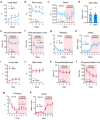Placental endocrine function shapes cerebellar development and social behavior
- PMID: 34400844
- PMCID: PMC8481124
- DOI: 10.1038/s41593-021-00896-4
Placental endocrine function shapes cerebellar development and social behavior
Abstract
Compromised placental function or premature loss has been linked to diverse neurodevelopmental disorders. Here we show that placenta allopregnanolone (ALLO), a progesterone-derived GABA-A receptor (GABAAR) modulator, reduction alters neurodevelopment in a sex-linked manner. A new conditional mouse model, in which the gene encoding ALLO's synthetic enzyme (akr1c14) is specifically deleted in trophoblasts, directly demonstrated that placental ALLO insufficiency led to cerebellar white matter abnormalities that correlated with autistic-like behavior only in male offspring. A single injection of ALLO or muscimol, a GABAAR agonist, during late gestation abolished these alterations. Comparison of male and female human preterm infant cerebellum also showed sex-linked myelination marker alteration, suggesting similarities between mouse placental ALLO insufficiency and human preterm brain development. This study reveals a new role for a placental hormone in shaping brain regions and behaviors in a sex-linked manner. Placental hormone replacement might offer novel therapeutic opportunities to prevent later neurobehavioral disorders.
© 2021. The Author(s).
Conflict of interest statement
The authors declare no competing financial interests.
Figures















Comment in
-
Placental signaling influences cerebellum development.Nat Neurosci. 2021 Oct;24(10):1343-1345. doi: 10.1038/s41593-021-00918-1. Nat Neurosci. 2021. PMID: 34518688 No abstract available.
References
Publication types
MeSH terms
Substances
Grants and funding
LinkOut - more resources
Full Text Sources
Other Literature Sources
Molecular Biology Databases
Research Materials

